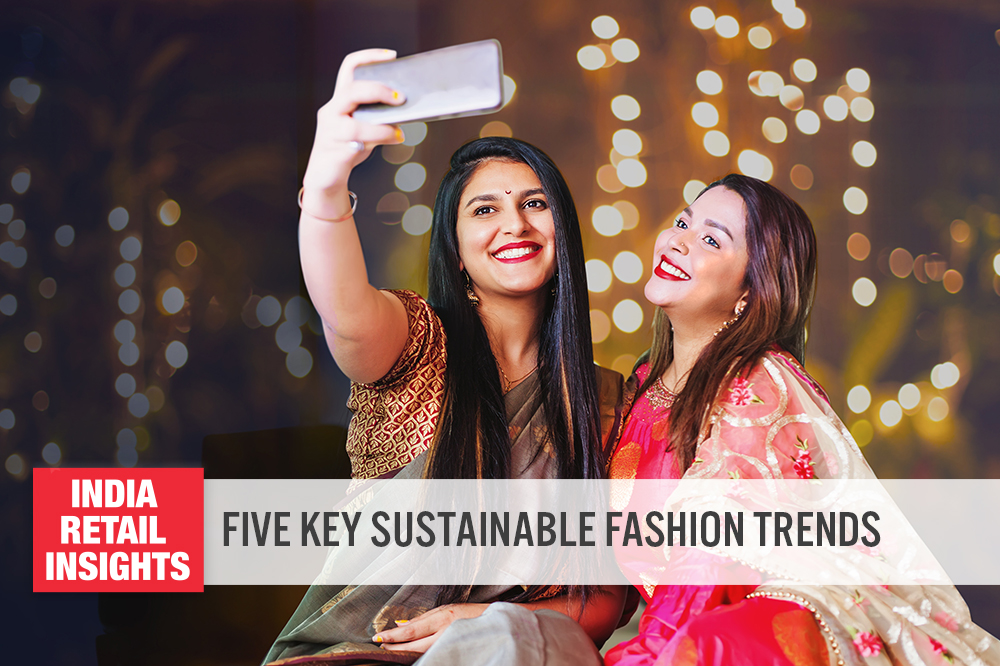
Nitheesh NH
What’s the Story?
Sustainability in apparel has evolved from a buzzword to a powerful theme, and is now an integral part of the culture of the Indian apparel industry. From fair treatment of workers and paying equal wages to the use of natural fabrics and organic dyes and eliminating supply chain malpractices, major brands, retailers and start-ups (predominantly in the organized sector) are adopting different strategies to embrace sustainability and integrate it into their core business strategies. Consumers have also become “responsible buyers” and increasingly switch to products from brands and retailers that prioritize sustainability across all spheres: people, processes and the planet. All this has made sustainability a crucial theme to understand within the Indian apparel industry. In this report, part of our India Retail Insights series, we examine five key sustainability trends in the Indian apparel industry and look at the different sustainability initiatives players are adopting.Why It Matters
Apparel brands and retailers in India are stepping up to address the environmental concerns linked to their industry and consciously moving toward sustainable practices. The Indian Textile Ministry, the Clothing Manufacturers’ Association of India (CMAI), the United Nations in India, and sports, lifestyle and entertainment company Rise Worldwide (formerly known as IMG-Reliance Limited) launched Project SU.RE in August 2019. Project SU.RE is a commitment by the apparel industry to chart a sustainable pathway for fashion, focusing on five key aspects as depicted in the figure below.Figure 1. Project SU.RE Focus Areas [caption id="attachment_135866" align="aligncenter" width="700"]
 Source: Ministry of Textiles/Coresight Research[/caption]
Globally, the apparel industry is one of the biggest contributors to environmental pollution. As the Indian population—the world’s second-largest, and 17.7% of the total, according to Worldometer projections of the latest UN data—continues to consume more apparel, the country accounts for a significant share of the environmental pollution. Brands’ and retailers’ realization of the need to address the fashion industry’s detrimental impact on the environment has generated a boom in sustainable fashion.
Source: Ministry of Textiles/Coresight Research[/caption]
Globally, the apparel industry is one of the biggest contributors to environmental pollution. As the Indian population—the world’s second-largest, and 17.7% of the total, according to Worldometer projections of the latest UN data—continues to consume more apparel, the country accounts for a significant share of the environmental pollution. Brands’ and retailers’ realization of the need to address the fashion industry’s detrimental impact on the environment has generated a boom in sustainable fashion.
Sustainability Trends in the Indian Apparel Industry: Coresight Research Analysis
Consumers are also increasingly aware of the apparel industry’s environmental impacts and their preference for sustainable clothing and practices is growing. The figure below shows findings from a consumer survey (covering 937 respondents aged 18–60 across five Indian cities) included in the India Sustainability Report 2020 by online fashion magazine The Voice of Fashion and the Indian Ministry of Textiles.Figure 2. India: Consumer Preference to Adopt Sustainable Practices in Fashion [caption id="attachment_135867" align="aligncenter" width="700"]
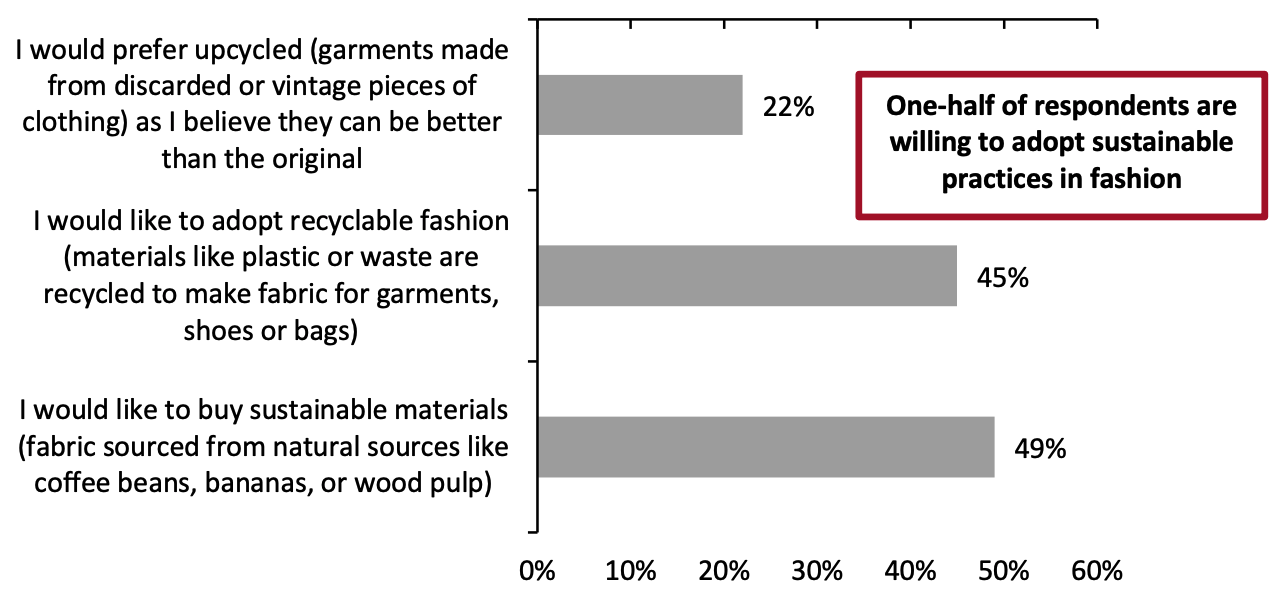 Source: India Sustainability Report 2020[/caption]
Furthermore, more than six out of 10 respondents believe that fashion should be responsibly produced. This shift in consumer mindset has supported brands’ and retailers’ move to produce sustainable fashion.
Below, we examine five key trends in sustainability in the Indian apparel industry and look at some of the players adopting different sustainability initiatives in their businesses.
Source: India Sustainability Report 2020[/caption]
Furthermore, more than six out of 10 respondents believe that fashion should be responsibly produced. This shift in consumer mindset has supported brands’ and retailers’ move to produce sustainable fashion.
Below, we examine five key trends in sustainability in the Indian apparel industry and look at some of the players adopting different sustainability initiatives in their businesses.
Figure 3. Five Key Sustainability Trends in the Indian Fashion Industry [caption id="attachment_135868" align="aligncenter" width="580"]
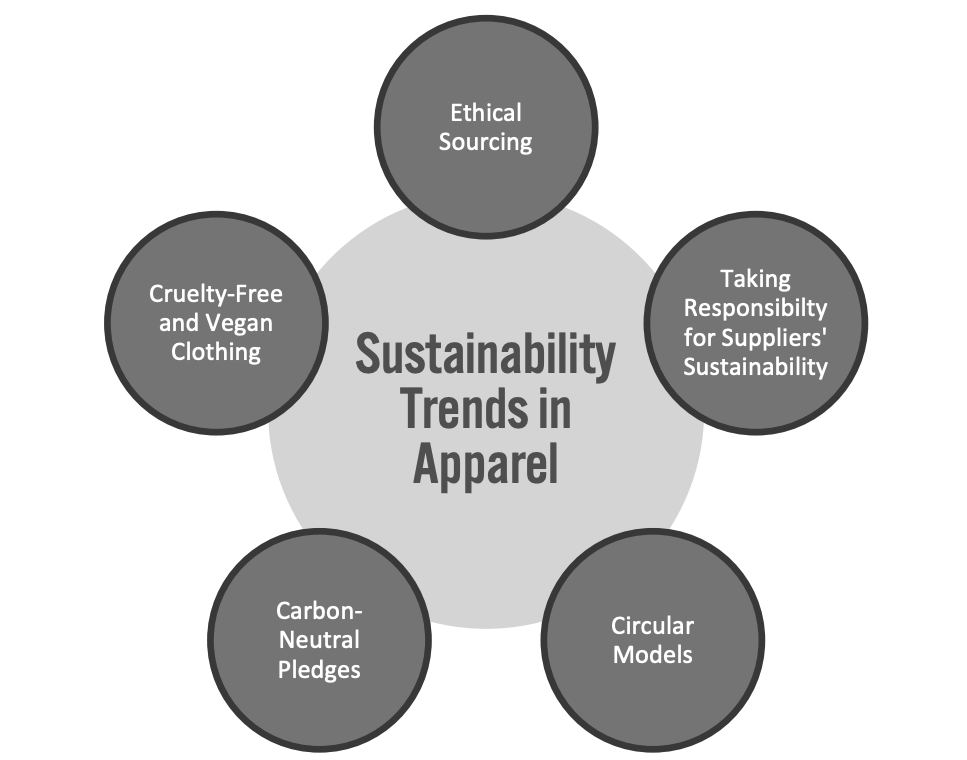 Source: Coresight Research[/caption]
1. Ethical Sourcing
Increasingly well-informed and vocal consumers are questioning the fashion industry’s prior model: unsustainable manufacturing practices, depletion of resources, material wastage and the associated environmental and social damage. Forward-looking apparel brands are now looking to create a new model of ethical sourcing to reduce textile waste and pollution—often through use of plant-based fibers and organic cotton, reducing environmental impact and waste.
Source: Coresight Research[/caption]
1. Ethical Sourcing
Increasingly well-informed and vocal consumers are questioning the fashion industry’s prior model: unsustainable manufacturing practices, depletion of resources, material wastage and the associated environmental and social damage. Forward-looking apparel brands are now looking to create a new model of ethical sourcing to reduce textile waste and pollution—often through use of plant-based fibers and organic cotton, reducing environmental impact and waste.
- Indian luxury fashion brand House of Anita Dongre sources from companies manufacturing biodegradable fabrics from renewable sources, and uses Bemberg—a sustainable Japanese fiber brand—in its clothing. Bemberg is a fiber brand made from cotton linter, a biodegradable and compostable by-product of cotton processing.
- House of Anita Dongre also uses Tencel fibers, which originate from wood; these fibers are manufactured using environmentally responsible processes and are also fully biodegradable and compostable.
- The brand is a member of the Better Cotton Initiative (BCI)—a global not-for-profit organization and the largest cotton sustainability program in the world that seeks to make global cotton production better for producers and the environment.
 House of Anita Dongre’s Sustainable Fibers Bemberg and Tencel
House of Anita Dongre’s Sustainable Fibers Bemberg and TencelSource: Company website[/caption]
- Leading fashion player Arvind Fashions Limited’s (AFL) lifestyle brand U. S. Polo Assn. has launched a range of “responsible jeans” produced using sustainably produced cotton and non-hazardous chemicals in the washing process.
- Indian fashion brand Liva’s proprietary new fabric is made with eco-friendly fibers and materials that are sourced from sustainable forests, consume less water and are biodegradable.
- AFL also claims that, during fiscal years 2020 and 2021 (which in India end March 31), it sourced more than 85% of its fabrics from the suppliers that adhered to its “Responsible Supply Chain (RSC)” guidelines, discussed in more detail below. AFL aims to increase this sourcing to more than 90% by 2025.
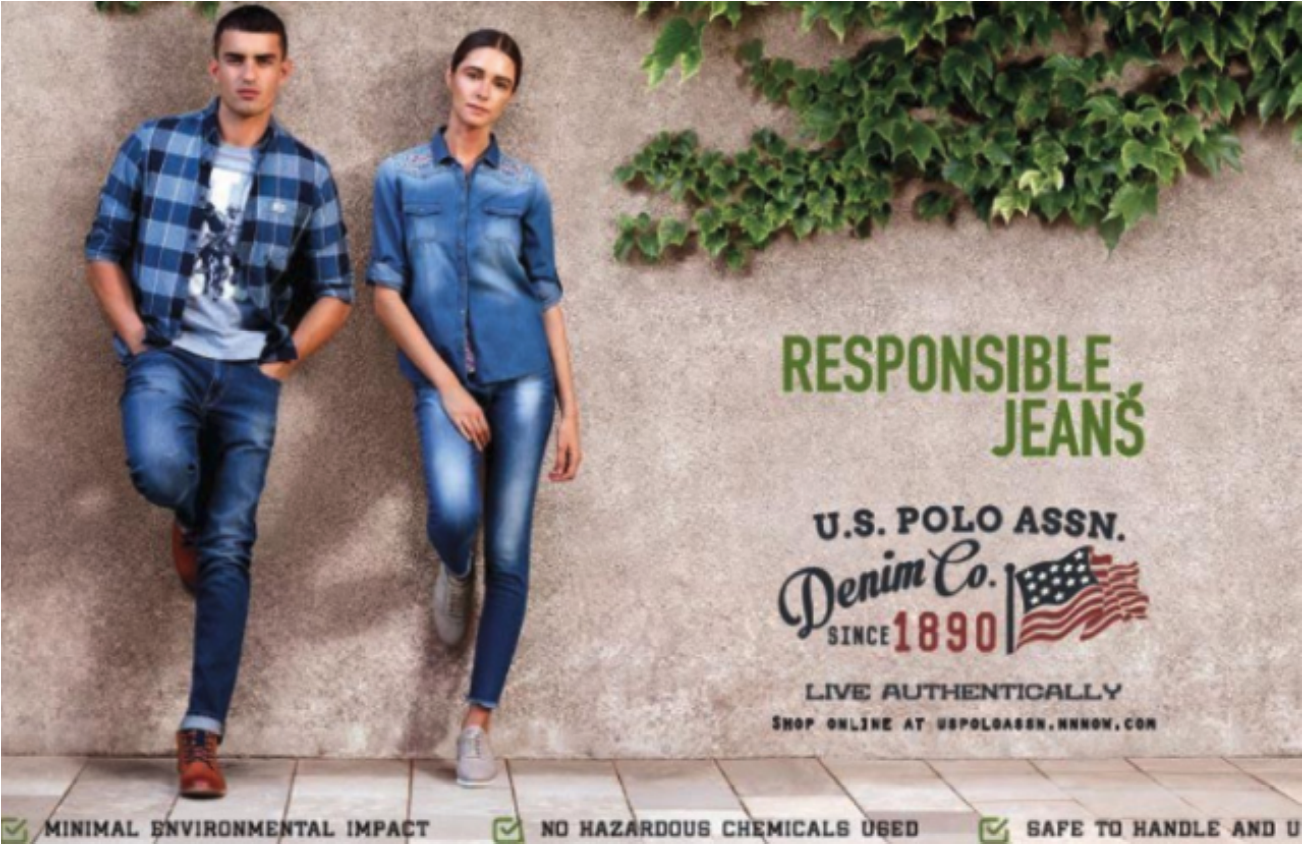 AFL’s responsible denim
AFL’s responsible denimSource: Company website[/caption] 2. Taking Responsibility for Suppliers’ Sustainability In addition to monitoring their own businesses’ sustainability, fashion brands are now moving one step further and taking responsibility for the sustainability of their suppliers and business partners. Many fashion brands now lay out sustainability guidelines for their suppliers’ business practices, including fair treatment of their workers, safe and appropriate working environments and no forced or child labor in their factories.
- In January 2018, AFL relaunched its “Responsible Supply Chain Guidelines (RSC),” its system to require its suppliers to follow sustainable business practices. The guidelines are still in effect and the requirements include:
- Suppliers should have a government-approved valid factory license to operate.
- No child labor or any form of forced labor in their factories.
- Fair and legal minimum wages for factory workers.
- No bribery.
- AFL is also a founding member of the Sustainable Apparel Coalition (SAC), which launched the Higg Index, a standardized suite of tools that measures the transparency and social and environmental impact of the fashion industry. As of March 2020, the company has encouraged nearly of its 50 vendor partner factories to register on the Higg Index.
- Leading Indian denim brand Spykar mentioned in its July 2019 sustainability pledge that it collaborates with vendors and service providers complying with nature conservation norms for producing apparel. Spykar’s entire denim range is manufactured at a plant in Maharashtra, India that follows several environmental preservation measures, including such as using 90% recycled water, infra-red dying to conserve fossil fuels and using 30% solar power for its energy requirements.
Figure 4. Garment Movement in a Circular Fashion Model [caption id="attachment_135871" align="aligncenter" width="580"]
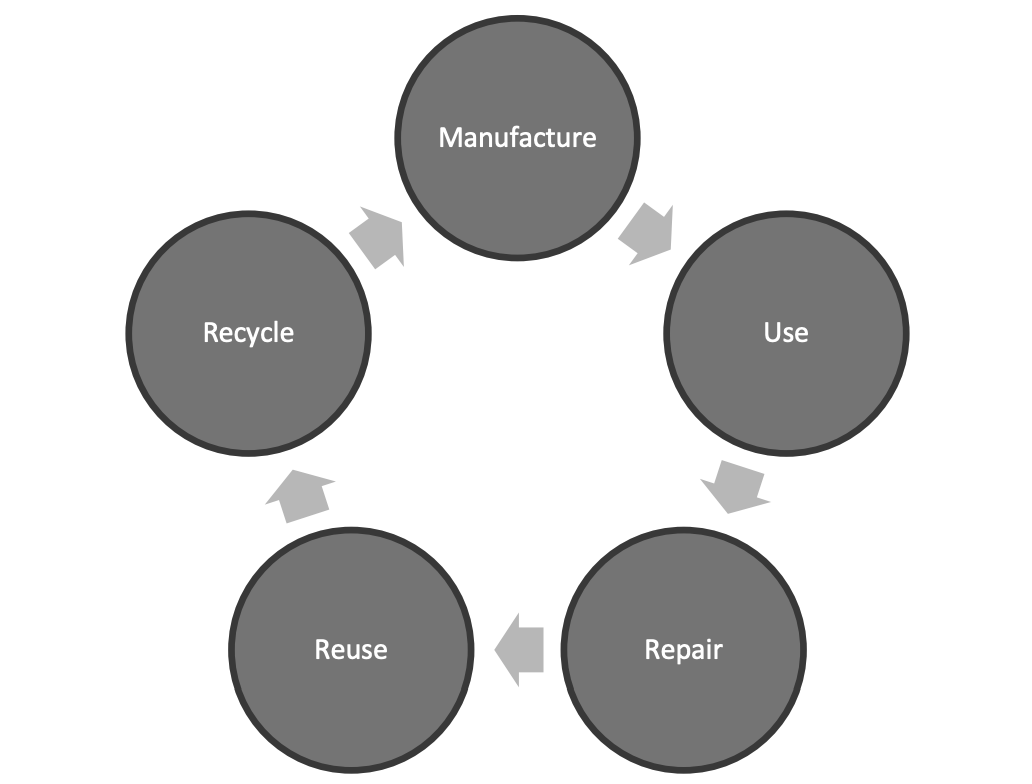 Source: Vogue India/Coresight Research[/caption]
Online fashion platform Twirl Store offers sustainable clothing and aims to reduce wastage. Twirl Store’s products are upcycled, limited edition and handcrafted. It operates a buy-back policy for clothes bought from its store, taking responsibility for the full lifetime of the products: when consumers no longer use their clothes, they can send them back and earn reward points. The clothes are used as fabric or provided to those in need, thus reducing wastage.
4. Carbon-Neutral Pledges
The apparel and textile industry is one of the biggest contributors to global carbon emissions. The fashion industry accounts for about 10% of all carbon emissions—more than all international flights and maritime shipping combined—and is the second-largest consumer of water resources, according to World Economic Forum (WEF) estimates.
To offset their carbon footprint, fashion brands calculate the carbon emissions generated by their materials, manufacturing and supply chain and offset this by investing in sustainable and renewable energy projects. Fashion brands such as No Nasties even go a step further and compensate for more than what they emit, to become carbon negative.
Source: Vogue India/Coresight Research[/caption]
Online fashion platform Twirl Store offers sustainable clothing and aims to reduce wastage. Twirl Store’s products are upcycled, limited edition and handcrafted. It operates a buy-back policy for clothes bought from its store, taking responsibility for the full lifetime of the products: when consumers no longer use their clothes, they can send them back and earn reward points. The clothes are used as fabric or provided to those in need, thus reducing wastage.
4. Carbon-Neutral Pledges
The apparel and textile industry is one of the biggest contributors to global carbon emissions. The fashion industry accounts for about 10% of all carbon emissions—more than all international flights and maritime shipping combined—and is the second-largest consumer of water resources, according to World Economic Forum (WEF) estimates.
To offset their carbon footprint, fashion brands calculate the carbon emissions generated by their materials, manufacturing and supply chain and offset this by investing in sustainable and renewable energy projects. Fashion brands such as No Nasties even go a step further and compensate for more than what they emit, to become carbon negative.
- Children’s wear brand Greendigo announced that it became carbon neutral from November 2020. Greendigo enables customers to experience its carbon-neutral journey on its website, while shopping. Every carbon-neutral product has a “carbon neutral” visual on the product page; by clicking on the visual, customers can see the exact amount of carbon offset for that product, and explore the projects that Greendigo invests in, including a degraded land reforestation project, a solar power project and a biogas plant that converts chicken droppings into renewable energy.
 Greendigo’s carbon-neutral journey on its website
Greendigo’s carbon-neutral journey on its websiteSource: Company website[/caption]
- Greendigo’s other sustainable initiatives include its use of plastic-free packaging and Global Organic Textiles Standard- (GOTS) certified organic cotton.
- ABFRL uses 87% sustainable packaging for its apparel products. Its lifestyle brand business achieved an 11.2% reduction in scope 1 emissions (direct greenhouse gas emissions from sources owned by the company) and scope 2 emissions (indirect greenhouse gas emissions and those occurring in the company’s value chain) further reducing its carbon footprint in FY20. The company also used 42% renewable water and 82% recycled and reused water across its facilities, and ensured “Zero Waste to Landfill” across all its facilities in FY20.
- No Nasties is an organic, carbon-negative and PETA-certified vegan clothing brand based in Goa, and the first Fairtrade-certified clothing brand in India. Its products are made from 100% organic cotton.
 No Nasties’ sustainable certification
No Nasties’ sustainable certificationSource: Company website[/caption]
- A Big Indian Story is a sustainable and PETA-certified vegan fashion brand. Its collections use alternatives to animal leather, including pineapple-based Pinatex, Cactus leather, Texon Vogue and PU, and are handmade. The brand supports Indian artisans and highlights Indian crafts in its designs.
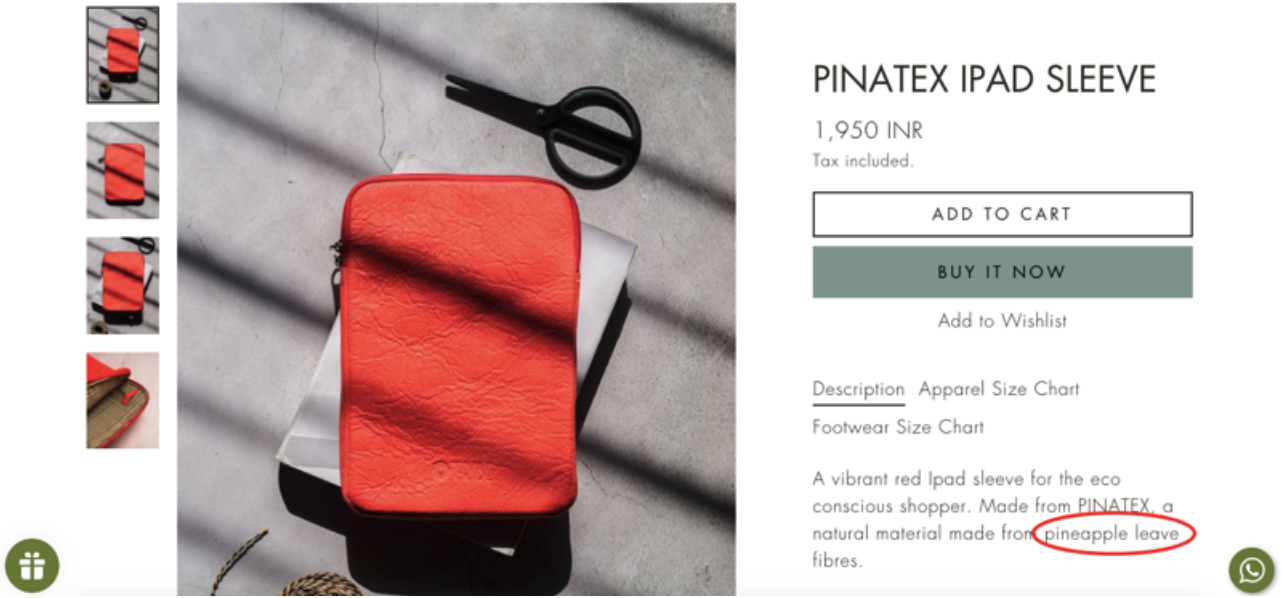 A Big Indian Story iPad cover made using Pinatex pineapple fiber
A Big Indian Story iPad cover made using Pinatex pineapple fiberSource: Company website[/caption]
What We Think
Climate change will impact the raw materials that the fashion industry relies on, especially cotton, and the regions where its manufacturing is based—indeed, it is already doing so. Sustainability in fashion is best understood not as a passing trend, nor even an intelligent response to consumer demand, but an essential shift for companies that intend to survive in the long term. Sustainability will become one of the key pillars for success for apparel brands and retailers. Implications for Brands/Retailers- Brands and retailers should adopt circular and sustainable models for resilience.
- Brands should focus on building sustainable supply chains through better collaboration with suppliers and partners, and convincing them to look at sustainability as an opportunity and its long-term benefits.
- Brands and retailers must harness disruptive innovations in raw materials, processes, and technologies for a more sustainable future in fashion.
- Apparel brands and retailers should transition to using renewable energy sources and electric vehicles, thus reducing their carbon footprint.
- Fashion brands should consider sustainable plant-based fibers such as hemp, bamboo and flax as alternatives to cotton.
- Artificial intelligence and machine learning technology vendors can partner with apparel brands and retailers to provide more accurate estimates of future demand, minimizing wastage to landfill.
- Textile innovation companies can help apparel brands and retailers to create their own sustainable fabrics.